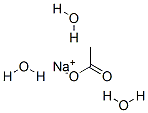| Identification | More | [Name]
Sodium acetate trihydrate | [CAS]
6131-90-4 | [Synonyms]
ACETIC ACID SODIUM SALT
ACETIC ACID SODIUM SALT TRIHYDRATE
SODA CAUSTIC
SODIUM ACETATE
SODIUM ACETATE 3H2O
SODIUM ACETATE-3-HYDRATE
SODIUM ACETATE TRIHYDRATE
Natriumacetat-trihydrat
sodiumethanoatetrihydrate
SODIUM ACETATE TRI.HYD.
Sodium acetate Food grade &medcine grade
SODIUM ACETATE-3-HYDRATE R. G., REAG. ACS, REAG. ISO, RE
SODIUM ACETATE-3-HYDRATE MAX.0,00002% AL
SODIUM ACETATE TRIHYDRATE, PH EUR
SODIUM ACETATE TRIHYDRATE SIGMAULTRA
SODIUM ACETATE TRIHYDRATE 99+% A.C.S.&
SODIUM ACETATE TRIHYDRATE, REAGENTPLUS, 99.99+%
SODIUM ACETATE TRIHYDRATE, REAGENTPLUS TM, >= 99.0%
SODIUM ACETATE TRIHYDRATE USP
SODIUM ACETATE TRIHYDRATE, ACS | [EINECS(EC#)]
204-823-8 | [Molecular Formula]
C2H9NaO5 | [MDL Number]
MFCD00071557 | [Molecular Weight]
136.08 | [MOL File]
6131-90-4.mol |
| Chemical Properties | Back Directory | [Appearance]
white to colourless crystals or powder | [Melting point ]
58 °C
| [Boiling point ]
>400°C | [bulk density]
900kg/m3 | [density ]
1,45 g/cm3 | [Fp ]
>250°C | [storage temp. ]
Store at RT. | [solubility ]
H2O: 3 M at 20 °C, clear, colorless
| [form ]
Solid | [color ]
White tranparent | [Odor]
Slight acetic acid | [PH]
7.5-9.0 (25℃, 50mg/mL in H2O) | [PH Range]
8.5 - 10 at 408 g/l at 25 °C | [pka]
4.76 (acetic acid)(at 25℃) | [Stability:]
Stable. Incompatible with strong oxidizing agents, halogens. | [Water Solubility ]
762 g/L (20 ºC) | [λmax]
λ: 260 nm Amax: ≤0.01
λ: 280 nm Amax: ≤0.01 | [Merck ]
14,8571 | [BRN ]
3732037 | [InChIKey]
AYRVGWHSXIMRAB-UHFFFAOYSA-M | [LogP]
-0.285 (est) | [CAS DataBase Reference]
6131-90-4(CAS DataBase Reference) | [NIST Chemistry Reference]
Sodium acetate trihydrate(6131-90-4) | [EPA Substance Registry System]
6131-90-4(EPA Substance) |
| Safety Data | Back Directory | [Hazard Codes ]
Xi | [Risk Statements ]
R36/37/38:Irritating to eyes, respiratory system and skin . | [Safety Statements ]
S24/25:Avoid contact with skin and eyes .
S36:Wear suitable protective clothing .
S26:In case of contact with eyes, rinse immediately with plenty of water and seek medical advice . | [WGK Germany ]
1
| [RTECS ]
AJ4580000
| [Autoignition Temperature]
607 °C | [TSCA ]
Yes | [HS Code ]
29152200 | [Toxicity]
LD50 orally in Rabbit: 3530 mg/kg LD50 dermal Rabbit > 10000 mg/kg |
| Questions and Answers (Q&A) | Back Directory | [Chemical Properties]
Anhydrous salt is a colorless crystalline solid; density 1.528 g/cm3; melts at 324°C; very soluble in water; moderately soluble in ethanol. The colorless crystalline trihydrate has a density 1.45 g/cm3; decomposes at 58°C; is very soluble in water; pH of 0.1M aqueous solution is 8.9; moderately soluble in ethanol, 5.3 g/100mL.
| [Uses]
Sodium acetate is a mordant in dyeing. Other applications are in photography, as an additive to food, in purification of glucose, in preservation of meat, in tanning, and as a dehydrating agent. In analytical chemistry it is used to prepare buffer solution.
| [Preparation]
Sodium acetate is prepared by reacting sodium hydroxide or sodium carbonate with acetic acid in aqueous solution. The solution is evaporated to obtain hydrated crystals of sodium acetate.
NaOH + CH3COOH → CH3COONa + H2O
Na2CO3 + CH3COOH → 2CH3COONa + CO2 + H2O
| [References]
[1] http://www.europlat.org
[2] http://www.rxlist.com/sodium-acetate-drug.htm
[3] http://cosmetics.specialchem.com
[4] http://cecri.csircentral.net/2710/1/036-96.pdf
|
| Hazard Information | Back Directory | [Definition]
ChEBI: Sodium acetate trihydrate is a hydrate. It contains a sodium acetate. | [Production Methods]
Sodium acetate is prepared by neutralization of acetic acid with
sodium carbonate. | [General Description]
Sodium acetate trihydrate can be obtained from the crystallization of sodium acetate in water. On heating at 75°C, it melts, while on heating above 120°C it loses water of crystallization and gets converted into anhydrous form. The hyperfine proton and 13C splittings have been evaluated by recording ESR spectra of its irradiated single crystals. ESR studies suggested the existence of trapped methyl radicals. Its crystals are monoclinic and its crystal structure has been investigated by photographic methods. Unit cell parameters were evaluated. | [Pharmaceutical Applications]
Sodium acetate is used as part of a buffer system when combined
with acetic acid in various intramuscular, intravenous, topical,
ophthalmic, nasal, oral, otic, and subcutaneous formulations. It may be used to reduce the bitterness of oral pharmaceuticals. It
can be used to enhance the antimicrobial properties of formulations;
it has been shown to inhibit the growth of S. aureus and E. coli, but
not C. albicans in protein hydrolysate solutions. It is widely used
in the food industry as a preservative. Sodium acetate has also
been used therapeutically for the treatment of metabolic acidosis in
premature infants, and in hemodialysis solutions. | [Biochem/physiol Actions]
Sodium acetate trihydrate (SAT) is a phase change material (PCM) that can be easily combined with the preparation of domestic hot water, space heating, solar heating, and radiant floor heating systems. The hydrated salt of SAT possesses high latent heat density and thus can be used for low-temperature heat storage. | [Safety]
Sodium acetate is widely used in cosmetics, foods, and pharmaceutical
formulations, and is generally regarded as a
nontoxic and nonirritant material.
A short-term feeding study in chickens with a diet supplemented
with 5.44% sodium acetate showed reduced growth rates that were attributed to the sodium content.(9) Sodium acetate is poisonous if
injected intravenously, is moderately toxic by ingestion, and is an
irritant to the skin and eyes.
LD50 (rat, oral): 3.53 g/kg
LD50 (mouse, IV): 0.38 g/kg
LD50 (mouse, SC): 8.0 g/kg | [storage]
Sodium acetate should be stored in airtight containers. | [Incompatibilities]
Sodium acetate reacts with acidic and basic components. It will
react violently with fluorine, potassium nitrate, and diketene. | [Regulatory Status]
GRAS listed. Accepted as a food additive in Europe. Included in the
FDA Inactive Ingredients Database (injections, nasal, otic, ophthalmic,
and oral preparations). |
|
|





